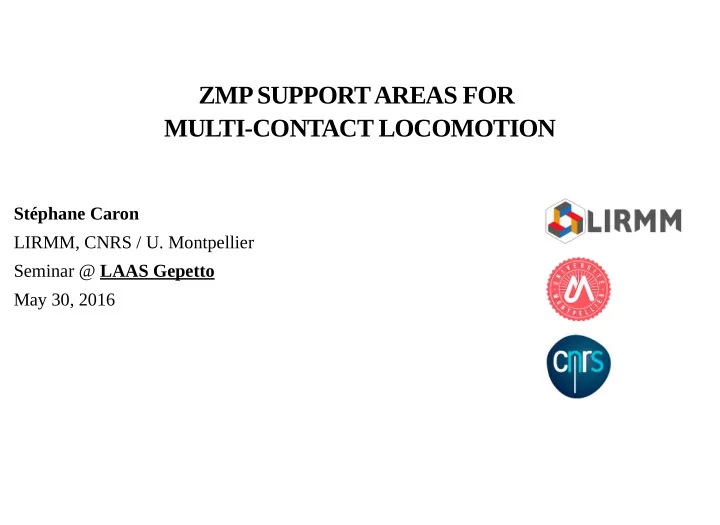

ZMP SUPPORT AREAS FOR MULTICONTACT LOCOMOTION Stéphane Caron LIRMM, CNRS / U. Montpellier Seminar @ LAAS Gepetto May 30, 2016
WALKING ON FLAT FLOORS Start from a footstep plan
WALKING ON FLAT FLOORS Start from a footstep plan Regulate system dynamics around the Linear Inverted Pendulum Mode (LIPM)
WALKING ON FLAT FLOORS Start from a footstep plan Regulate system dynamics around the Linear Inverted Pendulum Mode (LIPM) LIPM has simplified: Dynamics: ¨ x G = ω 2 ( x G − x Z ) Contact stability criterion: ZMP inside the support polygon
WALKING ON FLAT FLOORS Start from a footstep plan Regulate system dynamics around the Linear Inverted Pendulum Mode (LIPM) LIPM has simplified: Dynamics: ¨ x G = ω 2 ( x G − x Z ) Contact stability criterion: ZMP inside the support polygon Plan a trajectory for the pendulum
WALKING ON FLAT FLOORS Start from a footstep plan Regulate system dynamics around the Linear Inverted Pendulum Mode (LIPM) LIPM has simplified: Dynamics: ¨ x G = ω 2 ( x G − x Z ) Contact stability criterion: ZMP inside the support polygon Plan a trajectory for the pendulum Send it as reference to a wholebody controller
QUESTION
ZEROTILTING MOMENT POINT Definition The ZMP is traditionally defined as the point on the floor where the moment of the contact wrench is parallel to the surface normal (Sardain & Bessonnet, 2004) . Intuition The point at which the robot “applies its weight”. Contact stability The ZMP must lie inside the support polygon (convex hull of ground contact points). 1
LIMITATIONS This definition requires a single “floor” surface (no multicontact) The support polygon does not account for frictional limits (slippage, yaw rotations).
CONTACT STABILITY How to receive forces from the environment? Weak Contact Stability A motion or wrench is weak contact stable iff it can be realized by contact forces inside their friction cones. Contact Wrench Cone Friction cones can be combined as Contact Wrench Cone (CWC) at the COM—see e.g. (Caron et al., 2015) . By construction, w ∈ CWC ⇔ ∃{ f i ∈ FC i }, ⊕ f i = w .
ZMP OF A WRENCH The ZMP is mathematically defined from a wrench (Sardain & Bessonnet, 2004) . The ZMP in the plane Π( O , n ) of normal n containing O is the point such that n × τ Z = 0 : n × τ O x Z = + x O . n ⋅ f We define the full support area S as the image of the CWC by this equation.
CONTRIBUTION 1 Good news! The image of the CWC can be computed geometrically:
CONTRIBUTION 1 Bad news! It is not always a polygon:
CENTROIDAL DYNAMICS The NewtonEuler equations of the system are: f i [ m ¨ x G ] = [ mg 0 ] + ∑ [ ] − − → ˙ L G GC i × f i contact i m and g : total mass and gravity vector x G : acceleration of the center of mass (COM) ¨ L G : rate of change of the angular momentum ˙ f i : contact force received at contact point C i They show how the motion of unactuated DOFs results from interactions with the environment.
LINEAR PENDULUM MODE The Newton equation can be written equivalently: ˙ g + ¨ z G L Gx x G = ¨ ( x G − x Z ) − z G − z Z m ( z G − z Z ) where x now denotes XY plane coordinates. The Linear Inverted Pendulum Mode (Kajita et al., 2001) is obtained by constraining: z G − z Z = h ˙ L G 0 = The system dynamics become ¨ ( x Z − x G ) . g x G = h
OBSERV ATION The support area in the LIPM is smaller than the convex hull of contact points:
CONTRIBUTION 2 We provide an algorithm to compute the support area corresponding to the system: w ∈ CWC z G − z Z = h ˙ L G 0 = We call it the pendular support area .
PENDULAR SUPPORT AREA
PENDULAR SUPPORT AREA
PENDULAR SUPPORT AREA
PENDULAR SUPPORT AREA
PENDULAR SUPPORT AREA
PENDULAR SUPPORT AREA
PENDULAR SUPPORT AREA
LINEAR PENDULUM MODE We can now consider the ZMP above the COM ⇒ Linear (noninverted) Pendulum Mode: g x G = ¨ ( x G − x Z ) h This is the dynamic equation of a spring. Attractivity LIPM: the ZMP is a repellor of the COM LPM: the ZMP is a marginal attractor of the COM The robot is driven from above, controlling its target position.
MERCI POUR VOTRE ATTENTION.
Recommend
More recommend